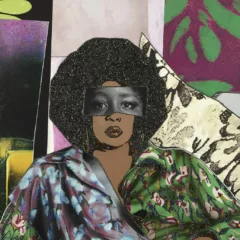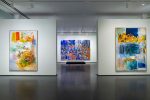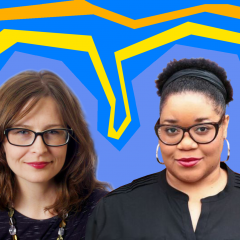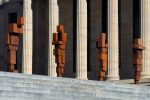I stood for 15 minutes with Murray and Minna, entranced by a video at Catherine Clark Gallery in San Francisco. We laughed out loud on a regular basis (you can hear us on the sound track now and then; the video itself was a silent film).
Thorsten Brinkmann, excerpt from video Gut Ding well es so. Turn the sound off to get the proper silent-movie effect.
Silent film is sort of the key word here. The video, Gut Ding will es so, by German artist Thorsten Brinkmann, has a Chaplinesque physical comedy to it. The artist/performer has a jaunty air as he carries in front of a static camera ordinary objects. He interacts with each in an unexpected way, and then carries the object off. Among the things he interacts with are a folding beach chaise, a large cardboard box, a dolly, an office-like arm chair, and a night stand. With the beach chaise, for instance, he sticks his arm into the support rungs and flaps the back and legs portion of the chair open and shut, looking like a butterfly).
For each new object, we waited with anticipation to see just how he would use it. Some of the actions were so simple that it seemed just plain dumb. Others were totally surprising. We were delighted by it all. The artist becomes a sort of Everyman, a bit misguided and lost as he explores the world of objects unmoored from their ordinary uses. He also takes on the objects as a piece of himself and vice versa.
By the way, that’s a lot of standing still. How about some chairs or a bench for viewing video???
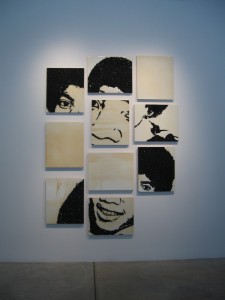
The video is part of the Remix exhibit up until August 15, which also includes work by Mickalene Thomas, Amir H.Fallah, Nicole Cherubini, Hilary Pecis and Carmen McCloud.
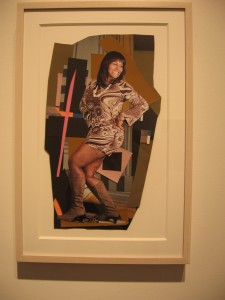
The Thomas photo collages insert unexpected images of African Americans in the gallery space and in an unexpected picture space. Her large, fractured image of a young Michael Jackson rendered in black sequins on white ground is more interesting as a concept than as an object that engages the eye.
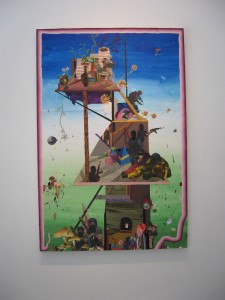
The Amir H. Fallah paintings and installation depict a cheery play-world at war. The warriors, heads wrapped in black, infiltrate either a backyard play house or maybe levels of a video game. The protest here is either anti-war or anti-profiling–equal opportunity criticism all around.
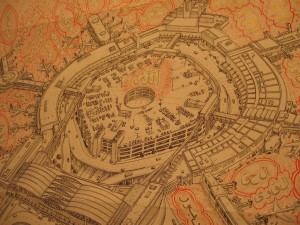
A preview of the gallery’s next exhibit makes me wish I could get there. It’s work by Sandow Birk. The American Qur’an series is gouache and ink on paper illuminated manuscripts (in English) with images of destruction. A couple of enormous drawings, The 99 Names of God, airport drawings by Birk and Elyse Pignolet, are spectacular aerial perspective maps with words, in English and Arabic. I just found some commentary by Roberta about other work by Birk and Pignolet comparing airports to Dante’s Inferno. (My mom used to compare the New York Port Authority to Dante’s Inferno! ) I think they are all on to something here.
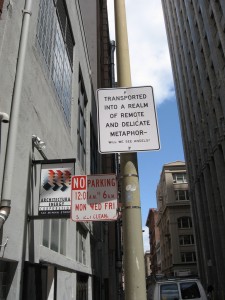
Outside the gallery, a “street sign” by Anthony Discenza caught our attention. (Thanks to that eagle-eyed Timothy Buckwalter for IDing the artist for me on my Flickr site). Discenza has a show coming up at Catherine Clark in December.
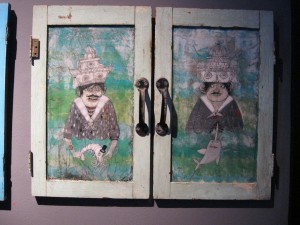
We also stopped at the 111 Minna Gallery, partly because Minna was with us. The watery fantasy drawings are collaborations by husband and wife team Kelly Tunstall and Ferris Plock.They have a turn-of-the-20th-century air, with mermaids, monsters and fish that look like airplanes and torpedoes, and wobbly sci-fi-fantasy structures like submarine skyscrapers and bathyscaphes amid the bubbles and kitshy girlies. They are lovely and engaging, with lots of texture and colors, coming in a variety of media and scale, including some reverse glass paintings on old windows.
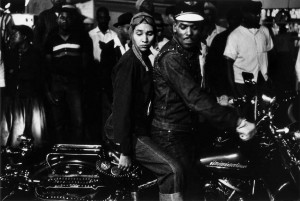
Last major stop for our day of art (by now Murray had dropped out) was the Robert Frank exhibit soon to close (Aug. 23) at the San Francisco Museum of Modern Art. Looking in: Robert Frank’s”The Americans” celebrates the 50th anniversary of the publication of the book The Americans with all 83 photos in the order of the book, plus a bunch of related photos and documents. Since I presume you all know the book, I won’t go on about it except to say we spent a long time there with the work, with its mix of politics and timeliness–an archive of a particular time and place. I especially wanted to visit this exhibit because of the wonderful Alec Soth talk I heard at Penn. Soth spent quite a bit of time discussing Frank’s influence on him. I would have bought a catalog, but I couldn’t bear the thought of carrying home the giant tome.
At the end of the exhibit was a small show of contemporary artists who were influenced by Frank. I didn’t see a Soth or a Zoe Strauss, to name just a couple of today’s important contemporary photographers he influenced. The photographers shown were all working in black and white, but that decision unfairly limited the true breadth of the influence Frank has had, and so it was a disappointment.
By now, Minna and I had had quite enough of art, so even though we did stop by the Yerba Buena Center for the Arts (Odili Donald Odita has a mural up there), I was too tired to take it in, and Minna was champing at the bit. Sorry, no pictures. Not allowed.
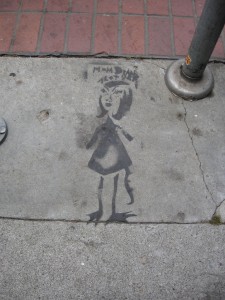
One more thing. The sidewalks of the city sported a variety of stenciled images–the people’s public art. Some of them were great. I have included a snap of my favorite.


